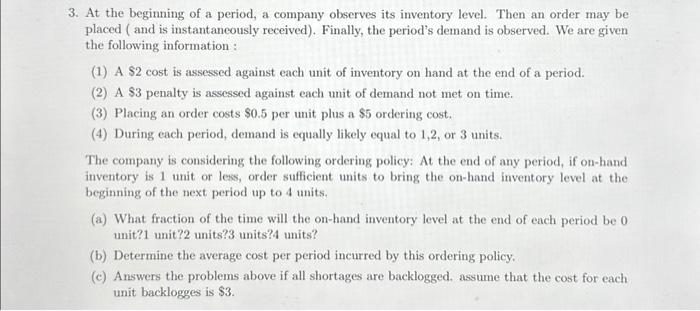Answered step by step
Verified Expert Solution
Question
1 Approved Answer
3. At the beginning of a period, a company observes its inventory level. Then an order may be placed (and is instantaneously received). Finally,

3. At the beginning of a period, a company observes its inventory level. Then an order may be placed (and is instantaneously received). Finally, the period's demand is observed. We are given the following information: (1) A $2 cost is assessed against each unit of inventory on hand at the end of a period. (2) A $3 penalty is assessed against each unit of demand not met on time. (3) Placing an order costs $0.5 per unit plus a $5 ordering cost. (4) During each period, demand is equally likely equal to 1,2, or 3 units. The company is considering the following ordering policy: At the end of any period, if on-hand inventory is 1 unit or less, order sufficient units to bring the on-hand inventory level at the beginning of the next period up to 4 units. (a) What fraction of the time will the on-hand inventory level at the end of each period be 0 unit?1 unit?2 units?3 units?4 units? (b) Determine the average cost per period incurred by this ordering policy. (c) Answers the problems above if all shortages are backlogged. assume that the cost for each unit backlogges is $3.
Step by Step Solution
★★★★★
3.34 Rating (145 Votes )
There are 3 Steps involved in it
Step: 1
a With the given ordering policy Probability inventory is 0 at end of period 13 Probability inventor...
Get Instant Access to Expert-Tailored Solutions
See step-by-step solutions with expert insights and AI powered tools for academic success
Step: 2

Step: 3

Ace Your Homework with AI
Get the answers you need in no time with our AI-driven, step-by-step assistance
Get Started


